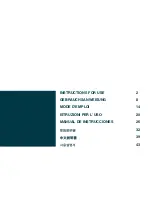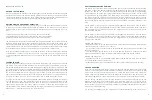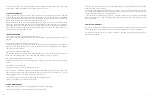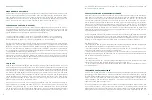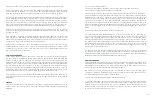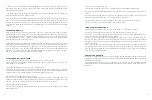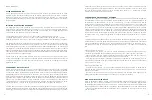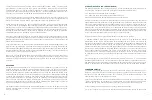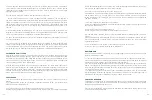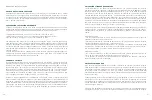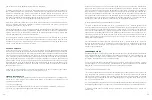
INSTRUCTIONS FOR USE
HOLD ON JUST A MINUTE
We can only imagine the intense excitement that grips you. Who the hell wants to read through an
instruction manual when the Diana+’s alluring plastic curves are calling your name? But please
– fight this temptation and digest this entire manual before you get started. There’s all kinds of
crucial info to make your first Diana+ photo shoot the very best that it can be.
GETTING STARTED AND FORMAT SELECTION
Your Diana+ uses 120 film. Before you do anything, you’ll need to decide what format you’d like
to shoot. You can choose amongst three sizes of images with your Diana+. Each size requires
a plastic mask (or lack of one), and a specific film format setting. The specifications are as fol
-
lows:
12 large square shots: (5.2x5.2cm) / no frame mask / 12-shot setting
16 small square shots: (4.2x4.2cm) / small frame mask / 16-shot setting
Endless panorama: (4.6x4.6cm) / small frame mask / 16-shot setting
The “frame masks” refer to the two small black plastic frames included with your camera. Turn the
Rear Door Switch
[1]
to “Open” and slide the Rear Door
[2]
off the camera. In the middle, you’ll
see the Mask Mount
[5]
, which is the area directly behind the lens. You can easily snap the frame
masks into place here. Use the small frame mask for 16 small shots, the panoramic frame mask
for Endless Panorama (more about that later!) and no frame mask for 12 large shots.
Once you’ve loaded the frame mask, you’ll need to set the Film Format Switch
[4]
on the back
of the Rear Door to either 12 or 16 shots. Just slide it up or down with your fingers, and match
it to the specifications listed above. Once your format is set, it’s time to load a fresh roll of 120
inside!
LOADING THE FILM
Remove the Rear Door
[2]
. Insert the fresh film roll into the left side. The film has holes on the top
and bottom of its spool – which will match with plastic posts on the top and bottom of the cam
-
era. Thread the film across to the right side Take-Up Spool
[3]
. You should only thread it in a little
bit – about a half-inch or two centimeters. With the Rear Door
[2]
still off, turn the Advance Wheel
[6]
counterclockwise, and ensure that the film is transporting and threading smoothly by turning
two or three complete revolutions. If you’ve got a lot of slack - or if the film is transporting at an
angle - then STOP, take out the film spool, and rewind it with your hands. Then give it another try.
If your film is loaded incorrectly, then it could scratch, fold, or break inside your camera.
Once you’re sure that the film is properly loaded, then replace the Rear Door
[2]
, turn the Rear
Door Switch
[1]
to “Lock,” and look through small red window on the Film Format Switch
[4]
.
120 film has its shot numbers printed on the back, so you can use this window to count your
exposures. As you advance, you’ll see a fragment of the word “Start” and then a sequence of
symbols (usually a few circles or dashes that go from large to small) which countdown to the first
exposure of “1.” Stop there, as you’re now ready to shoot.
SHUTTER AND APERTURE SETTINGS
The Diana+ is a fully manual camera which allows you to control how fast the shutter fires and
how wide it opens. The Shutter Speed Switch
[8]
, located on the top of the Lens
[11]
has two
settings: “N” and “B.” “N” is for normal daytime shots, and fires the shutter at approximately
1/60 of a second. “B” allows you to keep the shutter open for as long as you like – which is great
for nighttime and low-light images. For a sharp image, the camera must be held still whenever
you’re firing on the “B” setting! The best method is to screw a tripod into the Diana +’s handy
Tripod Mount
[15]
. Otherwise, try to press it against something flat and hold it steady while you
shoot. As the format is square, it doesn’t matter whether the camera is held horizontally or verti
-
cally.
On the bottom of the Lens
[11]
is the Aperture Setting
[9]
. This controls how wide the shutter
opens. There are four settings available. Three of them match the outdoor weather conditions:
sun, partial clouds, and full clouds. The forth one, designated as “P,” is for pinhole shots – which
we’ll discuss a little later.
On the bottom of the Lens
[11]
is the Aperture Setting
[9]
. This controls how wide the shutter
opens. There are four settings available. Three of them match the outdoor weather conditions:
sun, partial clouds, and full clouds. The forth one, designated as “P,” is for pinhole shots – which
we’ll discuss a little later.
With ISO 400 Speed Film
- In daylight, choose “N” for the shutter speed and match the aperture setting to the actual light
condition outside (ex. choose sun if it is sunny.)
- For a lit indoor setting, set the shutter to “B” and the aperture to cloudy. Shoot for about one
second or a little less.
- For night shooting, set the shutter to “B” and the aperture to cloudy. A brightly lit city street
needs about 20 seconds, and a really dark moonlit scene might need around a minute.
With ISO 100 Speed Film
- In daylight, choose “N” for the shutter speed and choose an aperture that’s one step darker.
(ex. choose partial clouds on a sunny day.)
- Double the shooting time of 400 speed film (ex. shoot indoor scenes for about 2 seconds).
FOCUS & SHOOTING
Okay, your film is advanced to number 1, and your shutter & aperture settings are in place. Take
a look at your subject and estimate the distance between you and them. The Focus Ring
[10]
is around the Lens
[11]
and has three settings: 1-2 meters (3-6.5ft), 2-4 meters (6.5-13ft), and 4
meters (13ft) to infinity. Rotate the Focus Ring
[10]
to the proper distance. And here’s a tip – the
Focus Ring
[10]
rotates out and moves closer to your subject as the focus setting gets closer.
You can handily compose your shot through the Diana+’s square Viewfinder
[13]
. As you can
imagine, the Viewfinder is not super-precise. It’s a little more correct for the 16-shot format.
When shooting 12 shots per roll, the actual image area is a bit larger than what the Viewfinder
shows. But don’t give it too much thought – the squnity Viewfinder and composition “surprises”
are all a part of Diana shooting.
Fire your very first Diana+ photo by pressing down the Shutter Release
[7]
. Press it once for day
-
2
3
Summary of Contents for DIANA+
Page 1: ......
Page 18: ...32 33 ...
Page 19: ...34 35 ...
Page 20: ...36 37 ...
Page 21: ...38 39 ...
Page 22: ...40 41 ...
Page 23: ...42 43 ...
Page 24: ...44 45 ...
Page 25: ...46 47 ...


